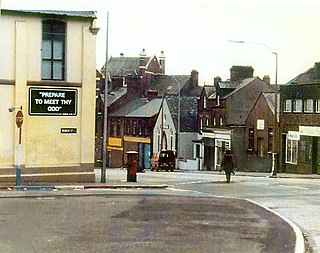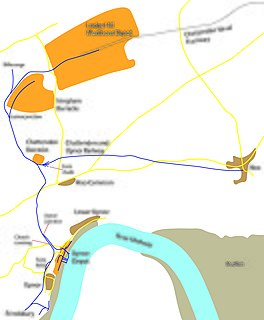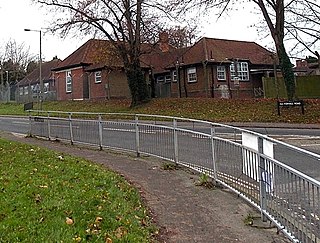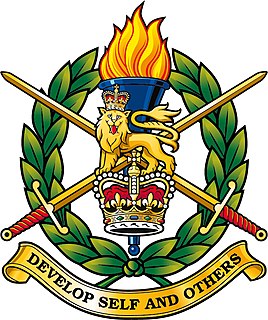
Bomb disposal is an explosives engineering profession using the process by which hazardous explosive devices are rendered safe. Bomb disposal is an all-encompassing term to describe the separate, but interrelated functions in the military fields of explosive ordnance disposal (EOD) and improvised explosive device disposal (IEDD), and the public safety roles of public safety bomb disposal (PSBD) and the bomb squad.

The Corps of Royal Engineers, usually called the Royal Engineers (RE), and commonly known as the Sappers, is a corps of the British Army. It provides military engineering and other technical support to the British Armed Forces and is headed by the Chief Royal Engineer. The Regimental Headquarters and the Royal School of Military Engineering are in Chatham in Kent, England. The corps is divided into several regiments, barracked at various places in the United Kingdom and around the world.

The Explosive Ordnance Disposal Badge is a military badge of the United States Armed Forces which recognizes those service members, qualified as explosive ordnance disposal (EOD) technicians, who are specially trained to deal with the construction, deployment, disarmament, and disposal of high explosive munitions including other types of ordnance such as nuclear, biological and chemical weapons along with improvised explosive devices (IED) and improvised nuclear devices (IND). Also known as the “EOD Badge” or "Crab", the decoration is issued by the United States Army, Air Force, Navy and Marine Corps. The EOD Badge is the only occupational badge awarded to all four services under the United States Department of Defense.

Lower Upnor and Upper Upnor are two small villages in Medway, Kent, England. They are in the parish of Frindsbury Extra on the western bank of the River Medway. Today the two villages are mainly residential and a centre for small craft moored on the river, but Upnor Castle is a preserved monument, part of the river defences from the sixteenth century.

United States Navy Explosive Ordnance Disposal technicians render safe all types of ordnance, including improvised, chemical, biological, and nuclear. They perform land and underwater location, identification, render-safe, and recovery of foreign and domestic ordnance. They conduct demolition of hazardous munitions, pyrotechnics, and retrograde explosives using detonation and burning techniques. They forward deploy and fully integrate with the various Combatant Commanders, Special Operations Forces (SOF), and various warfare units within the Navy, Marine Corps, Air Force and Army. They are also called upon to support military and civilian law enforcement agencies, as well as the Secret Service.

The Royal Army Ordnance Corps (RAOC) was a corps of the British Army. At its renaming as a Royal Corps in 1918 it was both a supply and repair corps. In the supply area it had responsibility for weapons, armoured vehicles and other military equipment, ammunition and clothing and certain minor functions such as laundry, mobile baths and photography. The RAOC was also responsible for a major element of the repair of Army equipment. In 1942 the latter function was transferred to the Royal Electrical and Mechanical Engineers (REME) and the vehicle storage and spares responsibilities of the Royal Army Service Corps were in turn passed over to the RAOC. The RAOC retained repair responsibilities for ammunition, clothing and certain ranges of general stores. In 1964 the McLeod Reorganisation of Army Logistics resulted in the RAOC absorbing petroleum, rations and accommodation stores functions from the Royal Army Service Corps as well as the Army Fire Service, barrack services, sponsorship of NAAFI (EFI) and the management of staff clerks from the same Corps. On 5 April 1993, the RAOC was one of the corps that amalgamated to form The Royal Logistic Corps (RLC).

The Royal School of Military Engineering (RSME) Group provides a wide range of training for the British Army and Defence. This includes; Combat Engineers, Carpenters, Chartered Engineers, Musicians, Band Masters, Sniffer Dogs, Veterinary Technicians, Ammunition Experts, Bomb Disposal Operators, and Counter Chemical Warfare experts, as well as Command and Leadership.

An ammunition technician (AT) is a British Army soldier, formerly of the Royal Army Ordnance Corps but since 1993 of the Royal Logistic Corps, trained to inspect, repair, test, store, and modify all ammunition, guided missiles, and explosives used by the British Army. These technicians are also trained to use demolition to safely dispose of individual items of ammunition and explosives (EODs) or to conduct logistics disposal of bulk stocks of multi items. After gaining sufficient experience, those who show the appropriate qualities are given extra training to render safe improvised explosive devices (IEDs) by a process called improvised explosive device disposal. Experienced ATs may be called to give evidence as expert witnesses in criminal or coroner's courts in relation to ammunition or explosives or to EOD and IEDD duties.

An ammunition technical officer (ATO) is an officer involved in all aspects of the army, air force, and navy's use of ammunition. This includes: bomb disposal, clearance of ERW, explosives accident investigation, procurement, in service management, storage, and inspection and repair.

The Chattenden and Upnor Railway was a narrow gauge railway serving the military barracks and depot at Upnor, Kent and associated munitions and training depots. It was preceded in the early 1870s by a temporary standard-gauge railway. The 2 ft 6 in narrow gauge was built in 1885, and continued in use until the end of 1961.
11 Explosive Ordnance Disposal and Search Regiment RLC is a specialist regiment of the British Army's Royal Logistic Corps (RLC) responsible for counter terrorist Explosive Ordnance Disposal (EOD), the safe recovery or disposal of conventional munitions. The regiment also has an ammunition inspectorate role supporting the Inspector Explosives (Army). With headquarters in Didcot, the regiment has sub units geographically based throughout the UK to provide a nationwide high readiness response capability in support of the police.

Defence Munitions (DM) Kineton occupies the site officially known as MOD Kineton, and is a Ministry of Defence property located close to the village of Kineton, Warwickshire, England.

Warrant Officer Class 2 Gary John O'Donnell, was a British Army bomb disposal expert who was awarded the George Medal twice. The George Medal is the second highest decoration for "acts of great bravery" not "in the face of the enemy". His second George Medal was the first such award in 26 years and the first ever posthumous bar. O'Donnell was killed in an improvised explosive device (IED) attack in Afghanistan.

Vauxhall Barracks is a military installation in Didcot, Oxfordshire.
Claro Barracks is a military installation at Ripon in North Yorkshire, England.

Chetwynd Barracks is a military installation at Chilwell in Nottinghamshire.

MoD Bicester is a large military storage and distribution centre just outside Bicester in Oxfordshire.

The Ordnance Corps (ORD) is a combat support corps of the Irish Army, a branch of the Defence Forces, that has logistical and operational responsibility for military ordnance in Ireland. The logistical role of the Army Ordnance Corps is to provide technical support to the Defence Forces for the procurement, storage, distribution, inspection, maintenance, repair and disposal of all items of ordnance equipment. The operational role of the Ordnance Corps is to train personnel for and provide the state's bomb disposal capability.

Chattenden and Lodge Hill Military Camps were British Army training camps in Chattenden and Hoo St Werburgh in Kent. They were built as ordnance depots and functioned as such through to the second half of the twentieth century.

The Army Recruiting and Initial Training Command (ARITC) is a two-star command of the British Army and "is responsible for all recruiting, selection, and basic training of soldiers and the recruitment and selection of officers".














